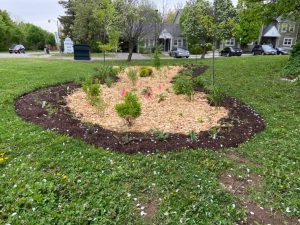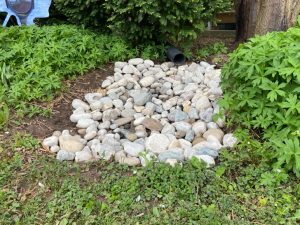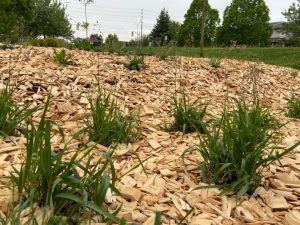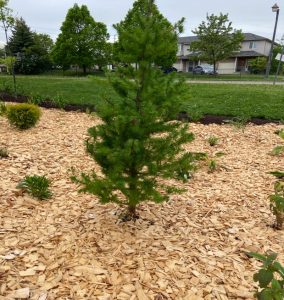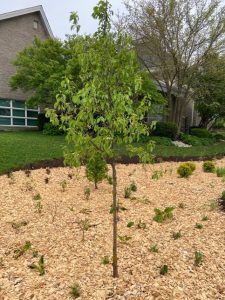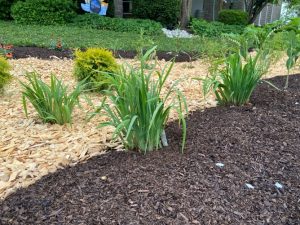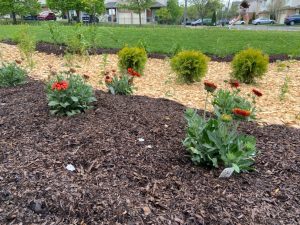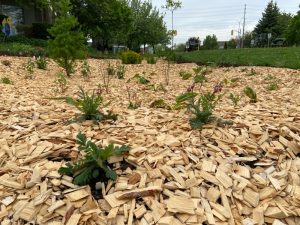RAIN GARDENS
What is a Rain Garden?
A rain garden is a unique landscaped feature – a type of green infrastructure – that collects the stormwater (rain and melted snow) that runs off your roof, down through your eavestroughs, and over the grass and/or driveway during a rainstorm or snowmelt.
A rain garden is also referred to as an infiltration plant – mirroring the natural water cycle – by managing excess water produced by storms and reducing standing water in your yard.
How Does a Rain Garden Work?
Strategically positioning a rain garden near eavestroughs maximizes the capture of stormwater, filtering the runoff of impurities through the plants’ deep root systems, and preventing it from entering the storm drain system (and later our waterways). Where possible, their construction will take advantage of natural depressions (e.g., swales). Otherwise, shallow depressions are created in the lawn to capture the stormwater runoff where it will soak into the ground – where it belongs!! – to nourish the garden plants and minimize overloading of local storm drains and prevent flooding. Rain gardens assist in mitigating extreme weather events (e.g., flooding, drought, and wildfires) – events we are increasingly experiencing due to climate change.
According to the World Wildlife Fund-Canada, “Rain gardens help weather both extreme wetness and extreme dryness: they can absorb up to 30% per cent more rainwater than a turf lawn and can make efficient use of limited water relative to lawns, which need watering during droughts to stay healthy” (WWF-C; 2023).
What does a Rain Garden Look Like?
While the basic construction principles for all rain gardens are similar (more on that later), rain gardens can come in all shapes and sizes, and their design can be as unique as their creator. A rain garden can complement a variety of different landscapes, be adapted to personal preferences, and take advantage of the existing topography or niches of space in your yard.
However, a rain garden functions best when created using native plants that are at home in the existing soil of your yard and love getting their roots wet (but can also tolerate drought). Native plants with deep roots give their plants extra stability, improve the soil conditions, and minimize soil erosion. Once established, they require less maintenance and care than non-native plants. Using native plants have the added advantage of attracting native pollinators – both generalists and specialists – that rely on native species for their survival (both food and shelter) – while at the same time provide a beautiful and colourful landscape encouraging lots of local fauna activity.
What Does the Rain Garden at Grace Look Like?
The rain garden at Grace United Church was constructed within an existing swale – taking advantage of the existing topography – in the backyard of its property. Its length is XX feet (YY metres) and its wide varies from xx – xxx feet (yy-yyy metres). Two existing downspouts from rooftop eavestroughs are located adjacent to the top end of the rain garden. Here, stormwater runoff moves across a short stretch of lawn and then enters the first of four rain garden tiers. Each tier is a flat depression surrounded by berms created using existing soil and covered with either compost mulch or maple wood chips. A wide range of plant specimens were carefully chosen and placed both within the basins and on the berms. At the bottom of the rain garden is an existing municipal storm drain where any excess runoff not absorbed by the rain garden will enter.
The plant specimens range from trees (e.g., Red Oak, Tamarack, and Nannyberry), to shrubs (e.g., Golden Globe Cedar, New Jersey Tea, Winterberry, and Scarlet Elder), to wildflowers (e.g., swamp milkweed, blue wild indigo, march marigold, Joe-Pye weed, blue flag iris) to grasses (e.g., sweet grass) – and many more. These native species will attract many birds (e.g., American Goldfinch), butterflies (e.g., Monarch), and insects (e.g., Eastern Common Bumblebee and the Deep Black Digger Wasp). A busy place!!
| SELECTED RAIN GARDEN PHOTOS | |
|
View from Top Tier Looking Down |
View from Bottom Looking Up |
|
Drainage Area below Downspouts |
Hierochloe odorata (Sweet Grass) |
|
Larix laricina (Tamarack) |
Viburnum lentago (Nannyberry) |
|
Polygonatum multiflorum (Solomon’s Seal) |
Iris Versicolor (Blue Flag) |
|
Gaillardia x grandiflora (Blanket Flower) |
Geum triflorum (Prairie Smoke) |
How Can I Create My Own Rain Garden?
Grace United Church used the services of Sean James Landscaping & Design consultants – experts in creating numerous rain gardens.
Under References below, are links to four Canadian websites that provide guidance in creating a rain garden. Grace United Church does not endorse any of these links – they are provided solely for information purposes. Anyone looking to create their own rain garden should consult local authorities (e.g., municipal by-laws, utility locates, etc.) and consult experts in the field of creating rain gardens. Look for landscape design firms in your local area that specialize in creating rain gardens.
Even if creating a rain garden is not your “thing”, consider installing rain barrels to collect rainwater and minimize the amount of rainwater that will otherwise either puddle on your lawn or enter the nearby storm drains. Also, consider planting flora species that are native to your area and will thrive in your existing soil. You will be surprised at the number of native faunae that will visit your garden. If you use mulch on your gardens, consider leaving a few small areas free of mulch to encourage native insects to make their home in the soil. Providing a water source for birds and bees/insects will encourage them to visit your garden and promote its pollination.
Happy Gardening!!
REFERENCES:
- Toronto and Region Conservation Authority. (2018, August 14). A Complete Guide to Building and Maintaining a Rain Garden.
2. Ontario Native Plants. Undated. Rain Gardens. https://onplants.ca/resources/rain-gardens/
3. Berry, C. (2023, May 31). What is a rain Garden (and How Does it Reduce Climate Change Impacts)? World Wildlife Fund – Canada. https://wwf.ca/stories/what-is-a-rain-garden-climate-change-impacts/?gad_source=1&gad_campaignid=10648121956&gbraid=0AAAAADtP0wTQY020T2glcKhFW6VW–a7R&gclid=Cj0KCQjwxJvBBhDuARIsAGUgNfhkkK0jjIeouOOsqeLqw8xY3sBS4hdELxS1NpGjzMEWVpMyRJlufnUaAsxmEALw_wcB
Canada Mortgage and Housing Corporation. (2020, May 11). Rain Gardens: Improve Stormwater Management in Your Yard. Government of Canada Publications. https://publications.gc.ca/collections/collection_2011/schl-cmhc/nh18-24/NH18-24-53-2011-eng.pdf

